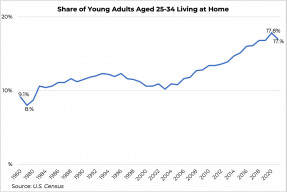The U.S. has been underbuilding housing for more than two decades. The reasons are plentiful: lack of skilled labor, availability and cost of land, local regulations which make building difficult, and the ongoing supply crisis.
Matt Christopherson, Research Analyst, and Sidnee Holmes, Research Assistant, were two of the lead authors of the report. In this conversational Q&A, they provide perspectives on how to use the report, insights into the data and the results they found to be most interesting.
Supply chain disruptions have led firms to lease additional industrial space to use as storage in an attempt to reduce reliance on supplier inventory.
Nearly half a million net new payroll jobs were added in January; that figure is over a million if we include independent self-employed business owners. Such gains also mean that the Federal Reserve will stick to—or even accelerate—its plan to raise interest rates.
Mortgage rates remained unchanged from the previous week at 3.55%. Following the trend of the 10-year Treasury yield, rates took a pause from their recent rally.
A strong and sustained job recovery, years of net domestic in-migration even during the pandemic, and the relative affordability of rental housing in these markets compared to other markets are drawing workers, businesses, and retirees.
Mortgage rates didn’t change much this week after moving upwards for the last 5 straight weeks. The 30-year fixed mortgage rate fell to 3.55% from 3.56% the previous week.
In 2020, the share of young adults aged 25 to 34 living at home grew to the highest share recorded since 1960. Regardless of the reason, living with family may provide a benefit to potential first-time home buyers.
The fraction of buyers who are waiving appraisal and inspection contract contingencies has been trending downwards in recent months, with REALTORS® saying that 19% of buyers waived the inspection contingency in December 2021, down from 27% in July, and 21% waived the appraisal contingency, down from 29% in June.
In spite of the increased spread of the omicron variant in the closing weeks of 2021, retail property fundamentals continued to improve. In Q4 2021, retail net absorption was close to the year's high (recorded in Q3 2021) as vacancy decreased to a pre-pandemic low and asking rents for retail space increased.
Search Economists' Outlook





























